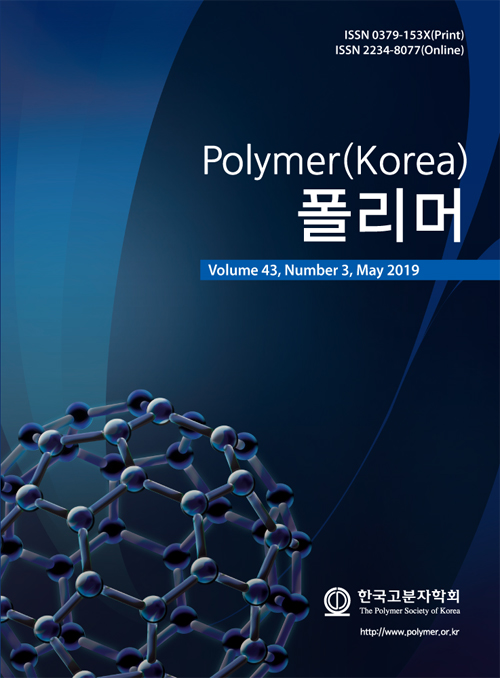- Effect of Main/Side Feeding Ratio of Carbon Fiber on the Properties of Nylon 66/Carbon Fiber Composites
Yu Shin Kim, Jun Seok Kim, and Youn Cheol Kim†
Major in Polymer Science and Engineering (Institute of IT Convergence Technology), Kongju National University, 1223-34 Cheonan-ro, Cheonan 31080, Korea
- 나일론66/탄소필러 복합체의 물성에 대한 탄소섬유의 주/부 투입비의 영향
김유신 · 김준석 · 김연철†
공주대학교 신소재공학부 고분자공학전공(IT용합기술연구소)
In this study, the effect of main/side feeding ratio of the carbon fiber on the physical properties of the nylon66/carbon filler composites was discussed. The carbon black (CB), multiwall carbon nanotubes (MWCNT), and nickel-coated carbon fibers (Ni-CF) were used as carbon fillers. Processing aids (2,2,6,6-tetramethyl-4-piperidinyl, BIS) and anti-oxidants were also used. The composites were fabricated by using a twin screw extruder at die temperature of 280 oC. The side/main feeding ratios of the composites are 20/0, 18/2, 14/6, 10/10, 6/14, 2/18, and 0/20. The concentration of Ni-CF was fixed at 20 wt%. As the side feeding content increases, the average length of fibers and mechanical properties of the composites were decreased but the EMI shielding performance was increased. Considering both mechanical properties and EMI shielding performance, the optimum side/main feeding ratio was determined as 14/6.
본 연구에서는 탄소섬유의 부/주 투입비율에 따른 나일론66/탄소필러 복합체의 물성에 미치는 영향을 고찰하였다. 복합체에 첨가된 탄소필러로는 카본블랙(CB)과 다중벽탄소나노튜브(MWCNT), 니켈 코팅된 탄소섬유(Ni-CF)등이 사용되었고, 첨가제로 흐름성개선제(2,2,6,6-tetramethyl-4-piperidinyl, BIS)와 산화방지제가 사용되었다. 복합체는 다이 온도 기준으로 280 oC 이축압출기에서 제조되었다. 복합체의 Ni-CF의 부/주 투입비는 20/0, 18/2, 14/6, 10/10, 6/14, 2/18, 0/20로 하였으며 Ni-CF 함량은 20 wt%로 고정하였다. 부 투입구의 함량이 증가할수록 섬유의 평균 길이와 기계적 물성은 감소하였으나 전자파 차폐 성능은 증가하는 결과를 나타내었다. 기계적 물성과 전자파 차폐 성능을 모두 고려할 때 부/주 투입비 14/6에서 최적의 물성을 나타내었다.
Keywords: nylon66, carbon filler, electromagnetic shielding, feeding ratio
- Polymer(Korea) 폴리머
- Frequency : Bimonthly(odd)
ISSN 0379-153X(Print)
ISSN 2234-8077(Online)
Abbr. Polym. Korea - 2023 Impact Factor : 0.4
- Indexed in SCIE
 This Article
This Article
-
2019; 43(3): 440-446
Published online May 25, 2019
- 10.7317/pk.2019.43.3.440
- Received on Feb 11, 2019
- Revised on Mar 14, 2019
- Accepted on Mar 18, 2019
 Correspondence to
Correspondence to
- Youn Cheol Kim
-
Major in Polymer Science and Engineering (Institute of IT Convergence Technology), Kongju National University, 1223-34 Cheonan-ro, Cheonan 31080, Korea
- E-mail: younkim@kongju.ac.kr








 Copyright(c) The Polymer Society of Korea. All right reserved.
Copyright(c) The Polymer Society of Korea. All right reserved.